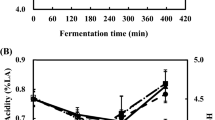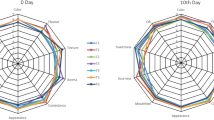Abstract
Microbiological, physicochemical, aroma and organic acid characteristics of non-fat yoghurt incorporated with β-glucan and probiotic Lactobacillus plantarum strains (AB6-25, AC18-82 and AK4-11) combination as adjunct culture were investigated during a 21 day storage period at 4 °C. Four treatment yoghurts contained 0.25, 0.5, 1 and 1.5 % β-glucan. Treatments also included probiotic combination and commercial culture. Treatments were compared with three controls produced containing commercial culture, commercial culture and probiotic combination, and commercial culture, Lactobacillus acidophilus and inulin. The results indicated that β-glucan promote the viability of lactobacilli. However, the addition of β-glucan (except 0.25 %) resulted in enhanced syneresis (P < 0.05). In general, the use of 0.25 % β-glucan had no significant effect on pH, fat, protein and organic acid content of non-fat yoghurt. The results obtained from this research demonstrated that the use of 0.25 % β-glucan has no adverse effect on the characteristics of non-fat yogurt produced with probiotic combination.



Similar content being viewed by others
References
Akın N (1997) İnek, koyun ve keçi sütlerinden üretilen fermente süt ürünlerinin organik asit miktarları. Gıda 22(1):35–41
Akoh CC (1998) Fat replacers. Food Technol 52:47–53
Alhendawi R, Romheld V, Kirkby E, Marschner H (1997) Influence of increasing bicarbonate concentrations on plant growth, organic acid accumulation in roots and iron uptake by barley, sorghum, and maize. J Plant Nutr 20(12):1731–1753
Anonymous (1981) Raw cow milk. TS 1018. Turkish Standard Institution, Ankara
Atamer M, Sezgin E, Alpar O (1986) Effect of the different heat treatment on some properties of yoghurt. Gıda 11:22–28
Başyiğit Kılıç G, Karahan AG (2010) Identification of lactic acid bacteria isolated from the fecal samples of healthy humans and patients with dyspepsia and determination of their pH, bile and antibiotic tolerance properties. J Mol Microbiol Biotechnol 18:220–229
Başyiğit Kılıç G, Kuleaşan H, Akpınar D, Sömer VF (2012) Determination of probiotic and technological properties of some Lactobacillus plantarum strains. TÜBİTAK, project report (unpublished), No 109 O 623, Burdur, Turkey
Başyiğit Kılıç G, Akpınar D (2013) The effects of different levels of β-glucan on yoghurt manufactured with Lactobacillus plantarum strains as adjunct culture. J Food Agric Environ 11(1):281–287
Brennan CS, Tudorica CM, Kuri V (2002) Soluble and insoluble dietary fibres (non-starch polysaccharides) and their effects on food structure and nutrition. Food Ind J 5:261–272
British Standard Institution (1955). Gerber method for determination of fat in milk and milk products, BS 696
Bujalance C, Jiménez-Valera M, Moreno E, Ruiz-Bravo AA (2006) Selective differential medium for Lactobacillus plantarum. J Microbiol Methods 66:572–575
Chaves ACSD, Fernandez M, Lerayer ALS, Mierau I, Kleerebezem M, Hugenholtz J (2002) Metabolic engineering of acetaldehyde production by Streptococcus thermophilus. Appl Environ Microbiol 68(11):5656–5662
Donkor ON, Nimlini SLI, Stolic P, Vasiljevic T, Shah NP (2007) Survival and activity of selected probiotic organisms in set-type yogurt during cold storage. Int Dairy J 17:657–665
Fernandez-Garcia E, McGregor JU (1994) Determination of organic acids in plain yogurt by high performance liquid chromatography. J Dairy Sci 77:2934–2939
Fernández-García E, McGregor JU (1997) Fortification of sweetened plain yogurt with insoluble dietary fiber. Zeitschrift fur Lebensmittel-Untersuchung und-Forschung 204:433–437
Gee VL, Vasanthan T, Temelli F (2007) Viscosity of model yogurt systems enriched with barley β-glucan as influenced by starter cultures. Int Dairy J 17:1083–1088
Guler Z (2007) Changes in salted yoghurt during storage. Int J Food Sci Technol 42:235–245
Güler Z, Taşdelen A, Şenol H, Kerimoğlu N, Temel U (2009) The determination of volatile compounds in set-type yoghurts by using static headspace gas chromatographic method. Gıda 34(3):137–142
Guven M, Yaşar K, Karaca OB, Hayaloğlu AA (2005) The effect of inulin as a fat replacer on the quality of set-type low-fat yogurt manufacture. Int J Dairy Technol 58:180–184
Havrlentová M, Petruláková Z, Burgárová A, Gago F, Hlinková A, Šturdík E (2011) Cereal β-glucans and their significance for the preparation of functional foods – a review. Czech J Food Sci 29(1):1–14
IDF (1962) Determination of the Protein Content of Milk. International Dairy Federation Standard (IDF) 28 A. Brussels, Belgium
Jaskari J, Konbula P, Siitonen A, Jousimes-Somen H, Matilla-Sandholm T, Potamen K (1998) Oat β-glucan and xylan hydrolyzates as selective substrates for Bifidobacterium and Lactobacillus strains. Appl Microbiol Biotechnol 49:175–181
Jenkins AL, Jenkins DJA, Zdravkovic U, Wursch P, Vuksan V (2002) Depression of the glycaemic index by high levels of beta-glucan fibre in two functional foods tested in type 2 diabetes. Eur J Clin Nutr 56:622–628
Kaminarides S, Stamou P, Massouras T (2007) Comparison of the characteristics of set type yoghurt made from ovine milk of different fat content. Int J Food Sci Technol 42:1019–1028
Keogh MK, O’Kennedy BT (1998) Rheology of stirred yogurt as affected by added milk fat, protein and hydrocolloids. J Food Sci 63:108–112
Kneifel W, Ulbert F, Erhard F, Jaros D (1992) Aroma profiles and sensory properties of yoghurt and yoghurt related products. I. Screening of commercially available starter cultures. Milchwissenchaft 47:362–365
Kucukoner E, Haque ZU (2003) Liyofilize edilmis protein kaynakli yag ikame maddelerinin Edam peynirinin tekstur ve olgunlasmasina etkisi. Gıda 28:227–233
Laye I, Karleskind D, Morr CV (1993) Chemical, microbiological and sensory properties of plain nonfat yogurt. J Food Sci 58:991–995
Lazaridou A, Biliaderis CG (2007) Molecular aspects of cereal b-glucan functionality: physical properties, technological applications and physiological effects. J Cereal Sci 46:101–118
Ligor M, Jarmalaviciene R, Szumski M, Marugka A, Buszewski B (2008) Determination of volatile and non-volatile products of milk fermentation processes using capillary zone electrophoresis and solid phase microextraction coupled to gas chromatography. J Sep Sci 31:2707–2713
Macciola V, Candela G, De Leonardis A (2008) Rapid gas-chromatographic method for the determination of diacetyl in milk, fermented milk and butter. Food Control 19:873–878
Ozer B, Kirmaci HA, Oztekin Ş, Hayaloglu A, Atamer M (2007) Incorporation of microbial transglutaminase into non-fat yogurt production. Int Dairy J 17:199–207
Purwandari U, Shah NP, Vasiljevic T (2007) Effects of exopolysaccharide-producing strains of Streptococcus thermophilus on technological and rheological properties of set-type yoghurt. Int Dairy J 17:1344–1352
Sahan N, Yasar K, Hayaloglu AA (2008) Physical, chemical and flavour quality of non-fat yogurt as affected by a beta-glucan hydrocolloidal composite during storage. Food Hydrocoll 22:1291–1297
Snart J, Bibiloni R, Grayson T, Lay C, Zhang H, Allison GE, Laverdiere JK, Temeli F, Vasanthan T, Bell R, Tannock GW (2006) Supplementation of the diet with highviscosity beta-glucan results in enrichment for lactobacilli in the rat cecum. Appl Environ Microbiol 72:1925–1931
Tamime AY, Robinson RK (1999) Yoghurt science and technology. Woodhead Publishing Limited, Cambridge
Tungland BC (2003) Fructooligosaccharides and other fructans: structures and occurrence, production, regulatory aspects, food applications, and nutritional health significance. ACS Symp Ser 849:135–152
Vasiljevic T, Kealy T, Mishra VK (2007) Effects of β-glucan addition to a probiotic containing yogurt. J Food Sci 72:405–411
Vinderola CG, Bailo N, Reinheimer JA (2000) Survival of probiotic microflora in Argentinian yoghurts during refrigerated storage. Food Res Int 33:97–102
Xanthopoulos V, Picque D, Basit N, Boquien CY, Corrieu G (1994) Methods for the determination of aroma compounds in dairy products: a comparative study. J Dairy Res 61:289–297
Zekovic DB, Kwiatkowski S, Vrvic MM, Jakovljevic D, Moran CA (2005) Natural and modified (1→3)-β-d-glucans in health promotion and disease alleviation. Crit Rev Biotechnol 25:205–230
Acknowledgments
The authors gratefully acknowledg the financial support provided by the The Scientific and Technological Research Council of Turkey (TÜBİTAK), Project No 109 O 623 and EU Commission (Cost Action FA 1001: The application of innovative fundamental food-structure–property relationships to the design of foods for health, wellness and pleasure). We would also like to thank Çavuşoğulları Süt ve Gıda Mamülleri Sanayi ve Ticaret A.Ş. (Burdur, Turkey), Güler Kimya Sağlık, Danışmanlık ve Dış. Tic. Ltd. Şti (İstanbul, Turkey) and Artısan Gıda San. Tic. Ltd. Şti. (İstanbul, Turkey) for providing the milk and starter cultures, β-glucan and inulin, respectively.
Author information
Authors and Affiliations
Corresponding author
Rights and permissions
About this article
Cite this article
Basyigit Kilic, G., Akpinar Kankaya, D. Assessment of technological characteristics of non-fat yoghurt manufactured with prebiotics and probiotic strains. J Food Sci Technol 53, 864–871 (2016). https://doi.org/10.1007/s13197-015-2055-1
Revised:
Accepted:
Published:
Issue Date:
DOI: https://doi.org/10.1007/s13197-015-2055-1




